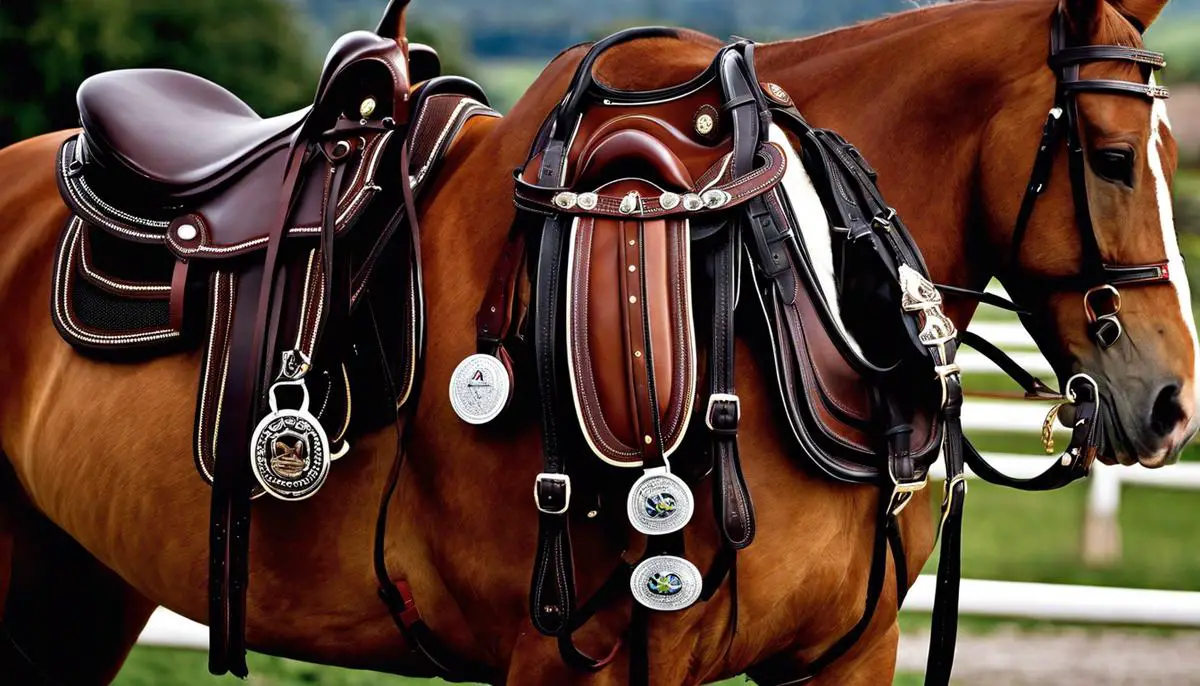The intricate world of equestrian equipment entails a rich trove of knowledge that spans materials, craftsmanship, maintenance, ethics, and informed purchasing decisions. Delving into the realm of Swiss horse tack specifically, we unearth unique qualities that reflect precision, tradition, and dedication to superior quality. This journey into the heart of Swiss horse tack involves an exploration of essential elements such as saddles, bridles, stirrups, and halters, and the craftsmanship that sets Swiss saddlery apart. Furthermore, we discuss the essentials of maintaining this tack and the ethical considerations involved in its manufacture and use. Additionally, useful purchasing advice is shared to ensure the hobbyists equip themselves most practically and efficiently.
Table of Contents (Horspedia)
Understanding the Essentials of Swiss Horse Tack
Decoding the Swiss Horse Tack: Essential Components and Their Uses
Swiss horse tack, often hailed for its craftsmanship and design, enjoys popularity among equestrian communities worldwide. Understandably so, Swiss tack is not just about fashion; it’s about function and ensuring the horse’s comfort and the rider’s safety. A closer look at the essential components reveals the reason behind the worldwide admiration.
Saddles, an indispensable part of any horse tack, function as a supportive structure for the rider. Swiss saddles, synonymous with fit and comfort, are usually made from premium leather and designed to shift the rider’s weight evenly across the horse’s back. Distinctively, they have a lower pommel and cantle, offering the rider a snug, secure fit without restricting movement.
Bridles, facilitating communication between horse and rider, hold significant importance. The Swiss bridle consists of a headstall, bit, and reins. The headstall holds the bit in the horse’s mouth, while the reins are the primary tool for transmitting signals from rider to horse. Swiss bridles are known for their precise fit. Each piece is adjustable to tailor to the horse’s head shape, ensuring comfort and clear communication.
Horse bits, though appearing simple, play an instrumental role in steering and stopping. Swiss bits, known for their balance between firmness and gentleness, come in various styles, depending on the horse’s training level and the rider’s skill.
Cinch or girth secures the saddle on the horse’s back. Swiss girths, typically made from leather or neoprene, are designed to prevent chaffing and discomfort. They feature buckles on both ends for easy attachment to the saddle and adjustment of tightness.
Stirrups, serving as the rider’s foot support, are an essential part of the tack for safety and balance. Swiss stirrups come with non-slip pads, providing maximum grip and comfort. Their design allows for quick foot release in case of an emergency, enhancing riders’ safety.
Lastly, saddle pads serve as a cushion between the saddle and the horse’s back, protecting the horse from friction and pressure. Swiss saddle pads are recognized for their breathability, comfort provision, and excellent-shock-absorbing qualities.
In the world of equestrian sports, Swiss horse tack, with its blend of comfort, safety, and style, truly stands apart. Armed with an understanding of its essential components, you’ll appreciate why Swiss horse tack is considered top-tier in the equestrian world. Here’s to experiencing unparalleled horse riding with Swiss tack!

Swiss Saddlery and Craftsmanship
The hallmark of Swiss saddlery and craftsmanship lies in its unique integration of tradition, precision, and innovation. Switzerland is world-renowned for its exceptional craftsmanship and an inexhaustible attention to detail, traits distinctly evident in its horse tack.
Unearthing the secrets behind any piece of Swiss-made horse tack, one can discover an irreplaceable blend of generations old traditional techniques combined with modern innovation. Swiss saddlers and craftsmen skillfully incorporate hand-stitched detailing into their bridles, which, while decorative, also attests to the quality and serviceability of the product.
It’s also important to note how Swiss saddle makers have continually innovated to improve the horse’s comfort and support the rider’s performance. For instance, they have carefully engineered treeless saddles to provide greater flexibility and adaptability to the horse’s back, offering superior comfort than traditional ones.
The bridles, too, receive special attention in Swiss practice. They are designed not just for optimal performance, but also with an understanding of the horse’s anatomy and behavior. The nosebands, for instance, are meticulously crafted to allow for adequate pressure distribution across the horse’s face, reducing discomfort or potential injury.
While bit fitting is somewhat universal, Swiss-made horse bits are known for their unique balancing. The weight and positioning of the bit pieces are perfectly harmonized for precise communication between the horse and rider, attesting to their precision crafting.
Even in elements as seemingly simple as cinch and stirrups, Swiss craftsmanship shines. Girths are designed with a wider center, distributing pressure evenly across the horse’s underside, reducing the risk of irritation or injury. Similarly, Swiss stirrups play a vital safety role with their anti-slip technology ensuring extra foot support.
Special mention should be made of the saddle pads. Swiss-made pads are a product of both practicality and aesthetics, with excellent shock-absorption properties for protecting the horse’s back and visually appealing designs bearing testament to the Swiss sense of elegance.
It is this adherence to detail, blending functionality with aesthetics and tradition with innovation, which places Swiss saddlery in a league of its own. The craftsmanship showcases not just a product, but a testament to Swiss heritage and passion. Every piece of horse tack emanates a skillful blend of precision and durability, making Swiss craftsmanship admired and sought after globally. For equestrians who view riding not merely as an activity, but an art, Swiss saddlery and horse tack are not just equipment – they are masterpieces.

Maintenance and Care of Swiss Horse Tack
Maintaining Swiss Horse Tack and Equipment For Durability and Longevity
One of the frequently overlooked aspects of owning Swiss horse tack and equipment is proper maintenance and care. While it is well-known for quality, longevity, and style, keeping Swiss horse tack in optimal condition requires the right methods. Here’s the proper way to maintain these exquisite pieces for long-term use.
Cleaning
Cleaning is a crucial part of horse tack and equipment maintenance. After each ride, remove any dust or dirt from the surface using a soft, damp cloth. Take extra care when cleaning the delicate parts, such as the leather components and metal fittings. Always take the time to gently clean and condition leather areas to prevent cracking or stretching over time.
Storage
Storing Swiss horse tack appropriately will significantly prolong its life. Keep it out of direct sunlight in a cool, dry place to avoid any damage by heat or excessive moisture. Additionally, ensure proper ventilation to prevent mildew or mold from spoiling the leather. More importantly, never store leather tack while it’s wet or even damp.
Regular Check-Up
Make it a habit to perform a thorough inspection regularly, looking out for any signs of wear or damage, for instance, in the stitching or buckles. Remember, early detection of abnormalities can save both cost and time in the long run.
Treating Leather
The use of oil and leather conditioner can greatly enhance the durability and improve the look of Swiss horse tack. Applying these products helps to maintain flexibility and prevent drying out, thus prolonging the life of the leather. However, be sure not to overdo it, as too much oil can make the leather overly soft and cause it to stretch or rip.
Taking Care of Metal Parts
Metal parts, such as bits, buckles, and stirrup irons, also need to be regularly inspected and cleaned. Applying a protective coating will help to prevent tarnishing or rusting.
While the techniques shared in maintaining Swiss horse tack and equipment may seem tedious, the results are truly rewarding. The difference between properly maintained equipment and poorly cared for one is evident not just in appearance, but also performance, lifespan, and, of course, horse comfort. Following these steps will ensure Swiss horse tack lasts for years, continuing to provide the same level of quality and performance that has made it a favorite choice worldwide in the horse-riding community.
Remember, all horse tack, especially those of Swiss-make, are a significant investment. Therefore, they deserve the most thorough care and attention to ensure they are always in the best possible condition. After all, we owe it to these masterpieces in the art of riding!

Ethical Considerations and Swiss Horse Tack
Delving deeper into Swiss-made horse tack, consideration for ethical practices takes precedence. As we explore the significance of Swiss horse tack, ethical sourcing and production cause for contemplation. How is the leather obtained? How are the horses treated during fittings? What environmental impacts might the construction and shipment of these prized pieces entail? These are essential ponderings that attend to the ethical compass required around the love of horses.
Swiss producers hold stringent benchmarks for their material sources. Genuine leather used in Swiss horse tack is sourced from animals raised and slaughtered humanely, ensuring the animal welfare standards are top-notch. The sourcing process is transparent, demonstrating respect for life, and asserting a primary ethical stance.
Animal treatment during fittings often stirs a hot debate in the world of horse tack. Swiss manufacturers stand out for their conscientious approach. In this regard, the fitting routines are conducted with minimum distress to the animals. The horse’s comfort is prioritized, with tactful, slow, and gentle fitting procedures in place. It’s an essential step that humanely safeguards the dignity of our equine friends, while outfitting them for superb performance.
The environmental footprint in constructing and distributing this top-grade equestrian gear also carries weight. Recognizing the value of a healthy planet, Swiss producers implement eco-friendly practices in their production processes. They adhere to principles of waste reduction and energy efficiency, aiming to achieve a fine balance between artisan quality and environmental responsibility.
Similarly, shipping is conducted with an ecological consciousness. By employing efficient logistical solutions, Swiss manufacturers can reduce fuel consumption and carbon emissions. This consideration enables us to enjoy these prized products without compromising the well-being of the Earth.
Swiss horse tack is more than a testament to high-quality craftsmanship and design; it’s a reflection of amiability towards animals and commitment to preserving our planet. In each meticulously designed piece, we see the imprint of ethics and love for equestrians. So, as we appreciate the marvelous Swiss horse tack, remember it’s a product steeped in tradition, innovation, functionality, beauty, and above all, ethical consideration.

Purchasing Swiss Horse Tack
When embarking on a journey to purchase Swiss horse tack, it’s imperative that one keeps a few significant factors in mind to make an informed choice. Known for their superior quality, durability, and particular attention to detail, Swiss horse tack represents a lifelong investment. Hence, understanding the various components and factors involved in the purchasing process is paramount.
The choice between custom or fitting options is a crucial decision for purchasers. Assessing the physical condition and distinct shape of the horse can help determine the suitable style of Swiss tack. While custom-made saddles provide a superior fit, improving both the rider’s comfort and horse’s performance, ready-to-use options are not to be dismissed as they significantly reduce cost and wait time and might fit just as well with the right adjustments.
A careful evaluation of the suitability of materials for your specific needs and circumstances is critical. While market-standard materials like leather, steel, and brass are commonly used, Swiss artisans also offer alternatives like biothane and synthetic materials, depending on your specific needs and budget.
As every rider knows, a horse’s comfort is paramount. To ensure optimal comfort, look for horse tack with features such as padded crownpieces on bridles and ergonomically designed saddle trees. These small attentions to detail can make a world of difference for your horse’s well-being.
While examining Swiss horse tack, one must always remember their impressive reputation does not only come from their quality and craftsmanship but also their ethical sourcing and production considerations. For example, suppliers ensure their leather sourcing process meets top animal welfare standards, and animals are treated ethically during fittings.
Purchasers should be aware that environmentally-friendly practices are often integrated into the production process of Swiss horse tack. Many Swiss saddlers aim to reduce the environmental impact of construction and shipment, using efficient shipping methods to lower fuel consumption and harrowing carbon emissions.
For those who see their commitment to horse riding as both a sport and a lifestyle, purchasing Swiss horse tack is more than just acquiring gear—it’s about making a pledge to uphold the harmony between rider and horse and valuing the shared history and artistry of the past and present equestrians. In doing so, every Swiss horse tack purchase reflects a rider’s respect for animals and dedication to preserving the planet. Now, proceed with confidence and gallop away.

Photo by johannasportfolio on Unsplash
Collectively, the knowledge of Swiss horse tack’s essentials, along with an appreciation for the craftsmanship involved in Swiss saddlery, assist in understanding its cultural and practical importance. Careful maintenance and ethical considerations further support responsible horsemanship, fostering a respectful relationship between humanoid and equine. By garnishing an informed view, hobbyists can make smart purchasing decisions that not only cater to their needs but also respect the integrity of the horse and the environment. By doing so, every stride taken with Swiss horse tack reverberates with the echoes of robust craftsmanship, ethical considerations, and the pursuant harmony between man and horse.

